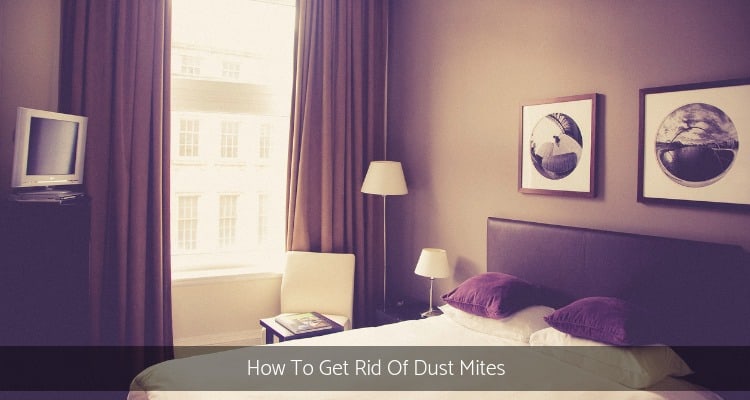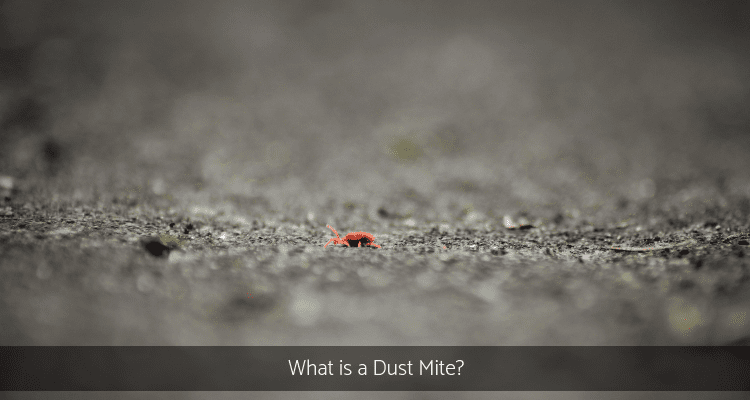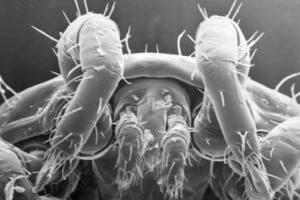Check out this close up and personal image of a house dust mite using a scanning electron micrograph at about 120 times magnification (Thanks to Allergen Control Services for taking this great shot).
Dust mites (Dermatophagoides pteronyssinus and Dermatophagoides farinae) are microscopic 8 legged members of the arachnid family (spiders and ticks) living in house dust. They are important triggers responsible for allergic disorders such as dust mite allergies.
The dustmite is so small, about 0.3 mm in length, that 50 of them can live on the head of a pin and up to 2 million can live in your mattress.
They live on a diet of skin scales, which we and our pets shed daily, as well as animal skin and mould. They thrive in warm, humid conditions, relative humidity 75 – 80% and temperature range 20 – 21ºC or more, making mattresses, doonas, pillows, underlays, blankets, quilts, carpets and rugs, upholstered furniture, curtains, clothes, soft toys, as well as your vacuum cleaner, a perfect environment to flourish in. Mite numbers reach a peak mid summer.
The dust mite lives between 2-4 months, with each female producing 20-50 eggs. The ususal population is about 100 to 500 dust mites per gram of dust (weight of a paper clip)!
Each dustmite produces up to 50 faecal droppings a day, one of the most common triggers of asthma and allergies. The only way to get rid of dust mite droppings is to get rid of house dust mites. Allergy specialists promote specifically designed dust mite covers providing welcome relief for asthma and allergy sufferers rather than using dust mite spray.
HOW TO:
How to get rid of dust mites
Are you constantly sneezing whilst in bed or on that soft lounge, and when you go out you feel better? Or are you the kind of person who has a runny, stuffy nose and red, itchy eyes no matter where you are indoors? Can’t stop coughing and sneezing? And the severe wheezing, shortness of breath that may bring on asthma symptoms? Does it seem like there is no way to get well in your home?

Dust mites absorb moisture from the atmosphere (mostly water from our skin and breathing) using small glands on the surface of their legs. They are less commonly found in dry, high altitude areas and they die when the humidity falls below 40-50% because they cannot get enough water from the atmosphere.
Dust mites don’t have eyes, yet have no trouble feasting on all the human dead skin flakes they can eat, which has been broken down by moulds in your mattress, pillow and doona. With excreted, sweaty moisture from our sleepy bodies and warm, cosy temperatures for at least eight hours a day, makes an ideal living environment. Another delicacy, based on a study, found that mites given a diet of dried semen residue and dead skin produced more dust mite eggs than other mites! Your mattress becomes a favourable breeding ground for dust mites, the mould that breaks down the skin scales and bacteria.
Keep in mind, dust mites only live in the environment, they don’t bite, don’t spread disease and never live on people. They are only unpleasant to people who become sensitive to dust mites allergy.
Compared to cat allergens and other materials that contribute to dust allergies, lint, feathers, mould and fungus spores, bits of insects and cockroaches, dust mite allergens are relatively heavy and tend to float less easily in the air. Therefore, mite allergen is close to the source, inhaling near a pillow, mattress, doona or a soft toy.
Pregnant female dust mites live for around 70 days, males around 10-19 days, around 40 trillion faecal pellets in your mattress over a 3 month period. Once they die off, they are constantly being replaced. One female lays 60 to 100 eggs.
PRODUCT:
Allerprotect Dust Mite Bed Set
Create a barrier between you and the dust mite allergens by enclosing the entire mattress, the entire pillow and the entire doona. Provides asthma and allergy relief by stopping the continual night time exposure to dust mite allergens while you sleep.

Faecal pellets dry up and become powdery, reducing the 15 micron size to an even much smaller size. Dust mite bedding prevents all the contaminants in your bed becoming airborne each time you roll over in bed, several times a night, or each time you fluff your pillow, or of course every time you and your significant other bounce on the bed.
Further methods of dust mite control include airing bedding, well ventilated and sunny, dry room, wash bed linen in hot water weekly and keep dust to a minimum. Covering your mattress correctly is important.
If you are looking for more information on the Dust Mite Fabric, we have created a research document here for you to read through. Please feel free to call us if you require any further information.
Towards healthier living Carol Parr ♥ and Tony Parr 😊
Our passion comes from pure necessity that we can all live natural and healthy lives, we can all contribute to human wellbeing and preservation and determine the future health of our children and their environment tomorrow.
As a result of working with us, women and their families thrive, work places and their personnel prosper, mouldy / chemical / electrical sensitive occupants heal. They’re healthier, they’re alert, they’re happier, more relaxed, more productive, and enjoying life.
Together we bring about healthy indoor environments and create rooms that provide calmness, healthy sleep, relaxation and restored energy for you and your family, create workplaces that provide ideal personnel attendance and elevated productivity.
By returning indoor spaces to more natural conditions, we strengthen you and your family and your personnel’s mind, body and spirit. It’s nice that it also sustains our planet’s ecology, you’d agree.
PS: Check out our latest enterprises here on the Mitey Fresh Facebook Page and here on my LinkedIn page.
References:
Platts-Mills TAE, Chapman MD. Dust mites: Immunology, allergic disease, and environmental control.
J ALLERGY CLIN IMMUNOL 1987;80:755-775. Online. Available: https://www.jacionline.org/article/S0091-6749(87)80261-0/pdf August 29, 2018
Author
-
We’re glad you’re here. We’re Carol and Tony, founders of one of the longest running Healthy Home Blogs in the world, Mitey Fresh Australia. We’ve been on this journey for the last 25 years and are passionate about helping families sift through health hazards and triggers like allergens, mould, water damage, chemicals and EMFs, to get clarity about what’s toxic and what’s not so they can create a healthy and happy home for their family they love. Each month, people visit this blog seeking focus on the health and wellbeing of their loved ones, sustainable and effective practice tips and guides, to help create and manage healthier indoor spaces, improve the built environment that is pleasing to the senses and support healthy living and nature, every day. Starting this blog was to help change people’s lives, one family at a time, and we can’t wait to share how its allowed us to stand next to you and show you how interpreting these synergies between buildings and the environment they are built in will impact upon the health and well-being of those who occupy them. Find out more about Healthy Homes and what this blog can do for you!






